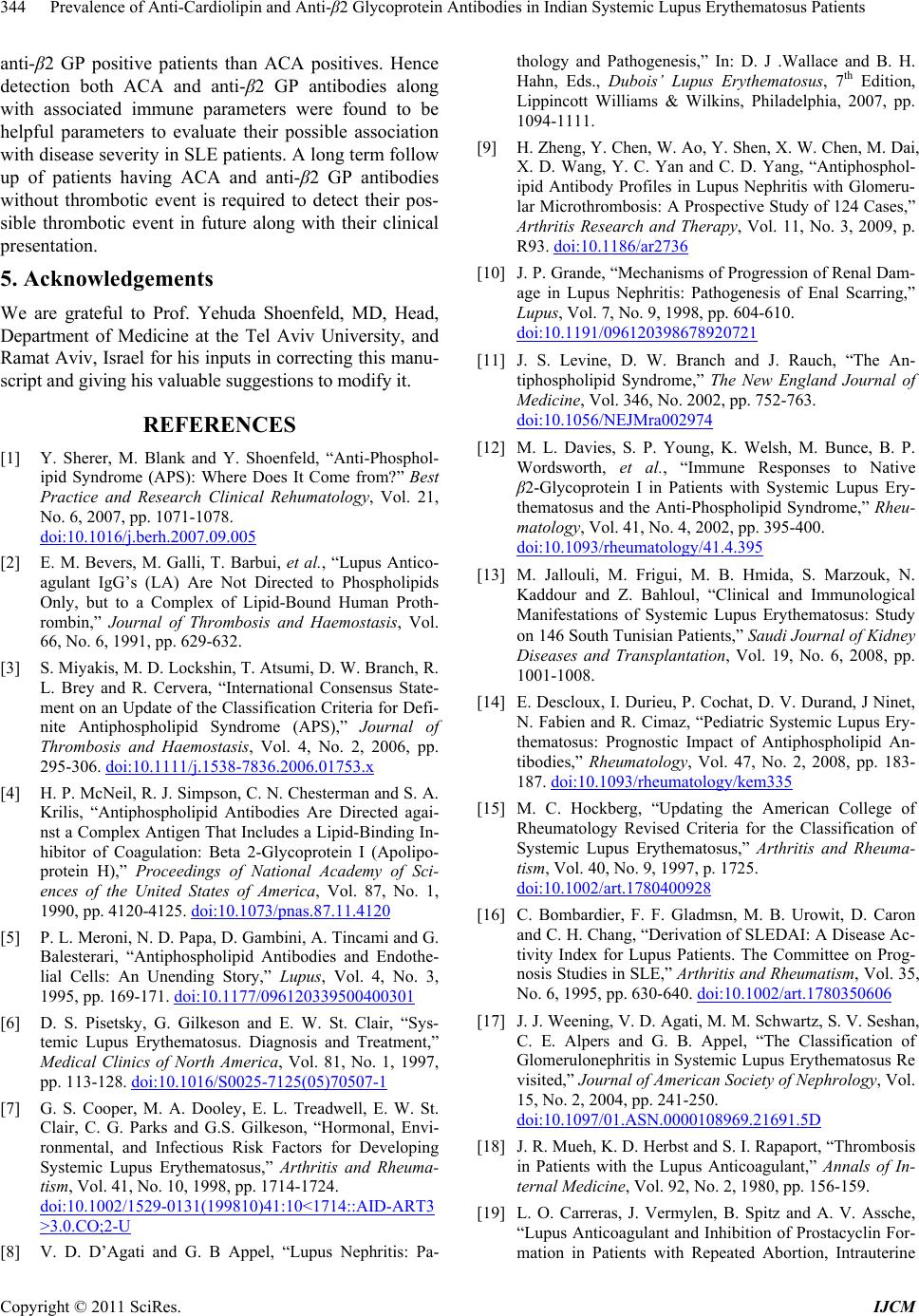
Prevalence of Anti-Cardiolipin and Anti-β2 Glycoprotein Antibodies in Indian Systemic Lupus Erythematosus Patients
344
anti-β2 GP positive patients than ACA positives. Hence
detection both ACA and anti-β2 GP antibodies along
with associated immune parameters were found to be
helpful parameters to evaluate their possible association
with disease severity in SLE patients. A long term follow
up of patients having ACA and anti-β2 GP antibodies
without thrombotic event is required to detect their pos-
sible thrombotic event in future along with their clinical
presentation.
5. Acknowledgements
We are grateful to Prof. Yehuda Shoenfeld, MD, Head,
Department of Medicine at the Tel Aviv University, and
Ramat Aviv, Israel for his inputs in correcting this manu-
script and giving his valuable suggestions to modify it.
REFERENCES
[1] Y. Sherer, M. Blank and Y. Shoenfeld, “Anti-Phosphol-
ipid Syndrome (APS): Where Does It Come from?” Best
Practice and Research Clinical Rehumatology, Vol. 21,
No. 6, 2007, pp. 1071-1078.
doi:10.1016/j.berh.2007.09.005
[2] E. M. Bevers, M. Galli, T. Barbui, et al., “Lupus Antico-
agulant IgG’s (LA) Are Not Directed to Phospholipids
Only, but to a Complex of Lipid-Bound Human Proth-
rombin,” Journal of Thrombosis and Haemostasis, Vol.
66, No. 6, 1991, pp. 629-632.
[3] S. Miyakis, M. D. Lockshin, T. Atsumi, D. W. Branch, R.
L. Brey and R. Cervera, “International Consensus State-
ment on an Update of the Classification Criteria for Defi-
nite Antiphospholipid Syndrome (APS),” Journal of
Thrombosis and Haemostasis, Vol. 4, No. 2, 2006, pp.
295-306. doi:10.1111/j.1538-7836.2006.01753.x
[4] H. P. McNeil, R. J. Simpson, C. N. Chesterman and S. A.
Krilis, “Antiphospholipid Antibodies Are Directed agai-
nst a Complex Antigen That Includes a Lipid-Binding In-
hibitor of Coagulation: Beta 2-Glycoprotein I (Apolipo-
protein H),” Proceedings of National Academy of Sci-
ences of the United States of America, Vol. 87, No. 1,
1990, pp. 4120-4125. doi:10.1073/pnas.87.11.4120
[5] P. L. Meroni, N. D. Papa, D. Gambini, A. Tincami and G.
Balesterari, “Antiphospholipid Antibodies and Endothe-
lial Cells: An Unending Story,” Lupus, Vol. 4, No. 3,
1995, pp. 169-171. doi:10.1177/096120339500400301
[6] D. S. Pisetsky, G. Gilkeson and E. W. St. Clair, “Sys-
temic Lupus Erythematosus. Diagnosis and Treatment,”
Medical Clinics of North America, Vol. 81, No. 1, 1997,
pp. 113-128. doi:10.1016/S0025-7125(05)70507-1
[7] G. S. Cooper, M. A. Dooley, E. L. Treadwell, E. W. St.
Clair, C. G. Parks and G.S. Gilkeson, “Hormonal, Envi-
ronmental, and Infectious Risk Factors for Developing
Systemic Lupus Erythematosus,” Arthritis and Rheuma-
tism, Vol. 41, No. 10, 1998, pp. 1714-1724.
doi:10.1002/1529-0131(199810)41:10<1714::AID-ART3
>3.0.CO;2-U
[8] V. D. D’Agati and G. B Appel, “Lupus Nephritis: Pa-
thology and Pathogenesis,” In: D. J .Wallace and B. H.
Hahn, Eds., Dubois’ Lupus Erythematosus, 7th Edition,
Lippincott Williams & Wilkins, Philadelphia, 2007, pp.
1094-1111.
[9] H. Zheng, Y. Chen, W. Ao, Y. Shen, X. W. Chen, M. Dai,
X. D. Wang, Y. C. Yan and C. D. Yang, “Antiphosphol-
ipid Antibody Profiles in Lupus Nephritis with Glomeru-
lar Microthrombosis: A Prospective Study of 124 Cases,”
Arthritis Research and Therapy, Vol. 11, No. 3, 2009, p.
R93. doi:10.1186/ar2736
[10] J. P. Grande, “Mechanisms of Progression of Renal Dam-
age in Lupus Nephritis: Pathogenesis of Enal Scarring,”
Lupus, Vol. 7, No. 9, 1998, pp. 604-610.
doi:10.1191/096120398678920721
[11] J. S. Levine, D. W. Branch and J. Rauch, “The An-
tiphospholipid Syndrome,” The New England Journal of
Medicine, Vol. 346, No. 2002, pp. 752-763.
doi:10.1056/NEJMra002974
[12] M. L. Davies, S. P. Young, K. Welsh, M. Bunce, B. P.
Wordsworth, et al., “Immune Responses to Native
β2-Glycoprotein I in Patients with Systemic Lupus Ery-
thematosus and the Anti-Phospholipid Syndrome,” Rheu-
matology, Vol. 41, No. 4, 2002, pp. 395-400.
doi:10.1093/rheumatology/41.4.395
[13] M. Jallouli, M. Frigui, M. B. Hmida, S. Marzouk, N.
Kaddour and Z. Bahloul, “Clinical and Immunological
Manifestations of Systemic Lupus Erythematosus: Study
on 146 South Tunisian Patients,” Saudi Journal of Kidney
Diseases and Transplantation, Vol. 19, No. 6, 2008, pp.
1001-1008.
[14] E. Descloux, I. Durieu, P. Cochat, D. V. Durand, J Ninet,
N. Fabien and R. Cimaz, “Pediatric Systemic Lupus Ery-
thematosus: Prognostic Impact of Antiphospholipid An-
tibodies,” Rheumatology, Vol. 47, No. 2, 2008, pp. 183-
187. doi:10.1093/rheumatology/kem335
[15] M. C. Hockberg, “Updating the American College of
Rheumatology Revised Criteria for the Classification of
Systemic Lupus Erythematosus,” Arthritis and Rheuma-
tism, Vol. 40, No. 9, 1997, p. 1725.
doi:10.1002/art.1780400928
[16] C. Bombardier, F. F. Gladmsn, M. B. Urowit, D. Caron
and C. H. Chang, “Derivation of SLEDAI: A Disease Ac-
tivity Index for Lupus Patients. The Committee on Prog-
nosis Studies in SLE,” Arthritis and Rheumatism, Vol. 35,
No. 6, 1995, pp. 630-640. doi:10.1002/art.1780350606
[17] J. J. Weening, V. D. Agati, M. M. Schwartz, S. V. Seshan,
C. E. Alpers and G. B. Appel, “The Classification of
Glomerulonephritis in Systemic Lupus Erythematosus Re
visited,” Journal of American Society of Nephrology, Vol.
15, No. 2, 2004, pp. 241-250.
doi:10.1097/01.ASN.0000108969.21691.5D
[18] J. R. Mueh, K. D. Herbst and S. I. Rapaport, “Thrombosis
in Patients with the Lupus Anticoagulant,” Annals of In-
ternal Medicine, Vol. 92, No. 2, 1980, pp. 156-159.
[19] L. O. Carreras, J. Vermylen, B. Spitz and A. V. Assche,
“Lupus Anticoagulant and Inhibition of Prostacyclin For-
mation in Patients with Repeated Abortion, Intrauterine
Copyright © 2011 SciRes. IJCM